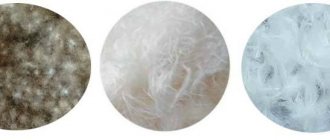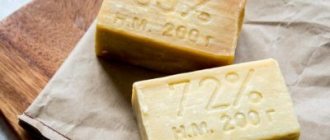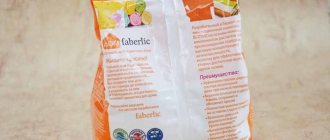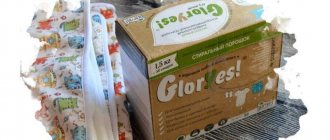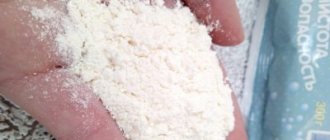– I usually buy washing powder and use it to wash everything – cotton, silk, woolen fabrics and synthetics. I heard that this is not always correct, that each fabric needs something different. Now I want to wash all my woolen items and put them in storage. Tell us what is the best way to do this? What should I use - powder, gel, shampoo or soap?
Anna Titova
Dry cleaning technologist
Wool fibers are made up of many cells. Each hair contains about 90% protein, which reacts negatively to any chemicals - acids, alkalis, solvents, etc. Any increase in their concentration helps to reduce the positive qualities of wool:
- stopping the release of lanolin and increasing wettability;
- increased electrification due to cuticle destruction;
- shrinkage and felting to the state of felt due to loss of elasticity;
- increased rigidity and coarseness due to keratinization of the hair core.
To avoid this, the following products are recommended for washing wool:
- Washing powder . The most optimal would be a powder based on natural soap. To prevent shrinkage, agents that dissolve at 30 °C are used. You cannot use powders with enzymes - enzymes that destroy protein contaminants. Chlorine bleaches are prohibited - strong oxidizing agents that destroy the color of fabric and its fibers.
- Gel . Its features are solubility in cold water, effective operation at low temperatures, and quick rinsing. Products containing lanolin, an animal wax emulsified with water, which restores the structure of the fibers and reduces the wettability of the fabric, will be effective.
- Shampoo . The most effective for woolen fabrics will be shampoos that contain amphoteric surfactants (cocamidopropyl betaine or decyl glucoside). Shampoos with surfactants based on sodium or ammonium phosphates (lauryls) are not recommended.
- Soap with lanolin . Used to remove local contaminants or for general washing in the form of shavings. Dissolves at 30 °C. When washing by hand, the fabric is soaked for 2-4 hours, followed by rinsing. When machine washing, the delicate cycle is activated.
Below you can find instructions on how to remove various stains, as well as reviews of laundry products and fabric care equipment.
— Anna Titova Dry cleaning technologist
Features of products for delicate fabrics
Usually there are much fewer natural wool products than items made from other fabrics. Therefore, it is better to select household chemicals for specific clothes. To do this, carefully read the information on the labels and manufacturers' recommendations. Depending on the dyes used and the exact fiber composition, the recommended washing temperature and required powder composition may vary.
The use of alkali is prohibited for cleaning any wool products. She treats the material aggressively and quickly renders it unusable.
In addition to surfactants, a good fabric washing product must contain caring components: conditioner and rinse aid. They make the fibers airy and give them a structure that is pleasant to the touch. Without them, the material becomes rigid and loses its appearance.
Despite the presence of special delicate cleaning modes in automatic machines, it is only possible to truly carefully deal with dirt through hand washing. In this case, you have the opportunity to properly prepare the working solution and reduce the intensity of the mechanical impact.
Tactics if woolen clothing shrinks
Woolen clothes shrink at the slightest temperature increase during washing. It is possible to return things to their original size, but the result will not always be as expected. Much of the success depends on the degree of shrinkage of the product - it is impossible to guarantee 100% achievement of the result. There are several techniques that can potentially return a shrunken wool item to its original parameters:
- When the yarn contains synthetic fibers, such clothes can return to their original size after 2 hours of soaking in 10 liters of cold water with 2 tbsp. hydrogen peroxide. After briefly drying with a towel, the product is left to dry. Periodically it is necessary to stretch the shrunken product into shape while it dries.
- With a high degree of probability, it is possible to return a woolen item to its previous size if you lay it out damp on an ironing surface, put a towel on top and iron it, carefully stretching it in the necessary places.
- You can return it to its original appearance using vinegar. A sponge is soaked in the liquid and the item is treated. Afterwards, the product is laid out on a horizontal surface, stretched to the required size and left to dry.
- If the sweater has shrunk, then it is permissible to wash it again with hair shampoo, lay it out on a hard surface while damp, and secure it in the required position with pins until it dries completely.
- You can stretch clothes made of natural wool by washing in 5 liters of water with 3 tbsp. ammonia and 1 tbsp. turpentine. The algorithm of actions is the same as in the case of repeated washing with shampoo.
Caring for wool clothing is a painstaking task. But if you do not follow the recommended rules, the product will quickly become unusable - it will become deformed, become hard, prickly, and pellets and matted areas will appear on it. All instructions regarding woolen products are mandatory, as they were developed empirically so that the items would last a long time and not lose their appearance over the years.
What to use for washing wool: gels or powders
Women have different attitudes towards powdered and liquid household chemicals. Each of them has its own advantages and disadvantages. But when it comes to the need to wash woolen items in an automatic machine, the gel has undeniable advantages:
- Dissolves quickly. Contact of aggressive components of the powder with fibers can lead to their damage. The faster the composition dissolves in water, the longer, and therefore more effectively, it removes contaminants from the fibers during the washing cycle.
- Works at low temperatures. The gel does an excellent job of removing stains even in cold water. Due to this, it is more careful with clothing fibers. This is especially true for colored items, where it is important to maintain the saturation and brightness of the shades.
- Rinses out quickly. The delicate cycle involves a short rinse. Not all powdery compounds are washed out of the fabric during this time. Due to the presence of aggressive components on the surface, allergic reactions or irritations on sensitive skin may occur.
At the same time, washing powder is excellent for hand washing. It is enough to prepare a solution of the required concentration in advance and wash woolen items in it until the dirt is completely washed out.
Choosing a detergent
Currently, on store shelves there is a huge amount of industrial household chemicals (powders, gels, conditioners) that can perfectly clean woolen items. Laundry detergents will help preserve color, fiber quality and give a lasting, pleasant aroma. What are their differences and advantages, and which one should you prefer?
Washing gel
This is a highly concentrated liquid product. It has a gentle effect on fabric, dissolves in water at 30 °C. Has the following advantages.
- Doesn't foam well.
- Cleans gently, so is suitable for light stains.
- Thanks to its liquid consistency, it washes out well.
- Preserves the color of delicate fabrics.
- Gives the pile softness and fluffiness.
Wool washing powder
Household chemicals with a free-flowing consistency.
- Wool powder, unlike regular powder, does not contain chlorine or aggressive components, and therefore does not destroy the structure of the fibers.
- Foams abundantly, removes stubborn dirt and grease stains.
- Doesn't wash well and requires a lot of rinsing.
Air conditioner
This is a rinse aid containing cationic surfactants and silicone, which gives it these properties.
- Softens wool fabric.
- Keeps colors vibrant.
- Repels dirt and moisture, as a result, the item stays clean longer.
- Makes ironing easier after washing.
- Prevents the formation of pellets.
Folk remedies
There are situations when you need to wash something urgently, but you didn’t have time to buy a special product or forgot. Or you suffer from allergic dermatitis and don’t want to experience a new advertised miracle household chemical product. Or a woolen item belongs to a baby son, seven months old, whose skin is sensitive and tender. Then, to help you, Russian housewives have accumulated over decades secrets on how to wash woolen items without consequences.
- Mustard. Suitable for black items and items that may fade. You need to mix a glass of dry mustard into cool water. After waiting 2 hours, strain and pour the prepared solution into 1 liter of warm water. Place the clothing in a bowl of solution. After waiting 10 minutes, you can start washing.
- Decoction of potatoes or white beans. Suitable for items with minimal dirt, it will carefully clean and refresh the product. Boil 1 kg of potatoes in 10 liters of water. After cooling and straining, wash the item. Rinse.
- Shampoo. On thin and delicate items made of mohair and cashmere, the shampoo will fluff and soften the lint. Do not use for machine wash!
- 3% hydrogen peroxide. If a white woolen item has turned yellow, you can return it to whiteness. Prepare a solution from 1 tsp. hydrogen peroxide per 5 liters of water. Place the item in it for 2 hours. Then wash and rinse thoroughly.
- Powdered chalk. Another way to save a yellowed item. Dissolve 1 kg of chalk in 3 liters of water. Soak the item in the solution for 10-20 minutes, stirring occasionally. Rinse with plenty of water and wash.
- Glycerol. Folk rinse aid will make the item soft and pleasant to the touch. You need to dilute 1 tbsp. l. glycerin in 5 liters of cool water and rinse the product.
Rating of the best washing powders for wool
We list the products that can quickly cope with cleaning woolen clothes. At the same time, they preserve their original appearance: without damage or other negative effects.
LUXUS Professional
The concentrate is intended for cleaning wool and silk fabrics. It is aggressive towards stains, but retains the original structure of the tissues. Conditioner particles maintain softness, and color-holding agents prevent dyes from washing out. The active formula does not contain chlorine or other aggressive components. Therefore, the product is gentle on delicate skin, which allows it to be used not only in automatic machines, but also in manual mode.
Faberlic “For wool”
The formula of Faberlic washing powder is based on the active action of plant components. Surfactants do their job well even at low temperatures. The concentrated formula reduces consumption by half compared to similar products. And the biodegradable base allows you to wash without harming the environment.
LV Color
The concentrate formula has a hypoallergenic effect. It perfectly removes dirt without causing irritation to the skin. The action is approved by the Finnish Association of Dermatologists. Caring components eliminate extraneous odors, give things freshness and a structure pleasant to the touch.
"Vorsinka"
The washing powder formula washes out various types of dirt well. At the same time, it preserves the structure of the fibers: it holds its shape perfectly, prevents the appearance of pilling, protects colored fibers from washing out dyes and gives softness to clothes. Thanks to its neutral pH value, the product is gentle on the skin.
"Cashmere"
Helps maintain its original appearance with frequent machine washing. Even if you wash often, things remain like new. The soap nut base perfectly removes dirt and refreshes the color. Silk extract has a caring effect.
The wool has stretched
If washing rules are not followed, products made from natural wool may stretch. To partially restore the original appearance of a thing, you need to turn it inside out. Then put a layer of gauze or thick natural fabric on top and iron it with an iron. When the product is not completely deformed, but a separate element, for example, sleeves, is stretched, they should be soaked for 10 minutes in warm water. Then dry with a towel and leave to dry on its own.
For reference! When the item stretches by more than 1 size, the item is immersed in hot (40-50 C) water. But, it is necessary to take into account that this technique is extremely aggressive towards woolen products and destroys the structure of the material. In addition, clothing may shrink more than necessary. For this reason, this technique is used only when other options have not given a positive result.
How to properly wash woolen items by hand
Here are a few recommendations that can effectively remove stains and maintain an attractive appearance:
- Immediately before washing, turn all items inside out. We carefully inspect them for damage. If they exist, we eliminate them.
- Prepare the solution - add the required amount of washing powder to water at a temperature of about 30 degrees, thoroughly dissolve it and beat it with your hands into a rich foam.
- Soak things in the prepared mixture. It is important to use plenty of water.
- Gently rub the material in the most contaminated areas until they are completely washed out. It is important not to allow the fibers to stretch.
- After washing and rinsing, place each item in a terry towel and wring it well.
- We dry our clothes by laying them out on the table or floor. If you hang things on a clothesline, the back of a chair or a radiator, the material will stretch a lot.
Now you know how to choose the right washing powder for wool and carefully remove dirt. This means you can independently maintain the attractive appearance of your clothes.
If you find an error, please select a piece of text and press Ctrl+Enter.
General Tips
To maintain the normal appearance and condition of a woolen item, sometimes it is not enough to follow the standards of care. There are products that require a more thoughtful attitude and a complete list of rules and regulations, for example, some woolen sweaters must be checked for the possibility of shedding before washing. In order for the item to last longer it is necessary:
- When storing woolen items, additional moth repellents should be placed in the closet. As such, you can use soap or pieces of dried citrus peel.
- If there are long loose loops on the product, they must be picked up and carefully hemmed, otherwise during the washing process they may stretch out and lead to the unraveling of the knitting.
- When cleaning items made from soft wool like alpaca or mohair, hand washing with shampoo is the best option. However, rinse thoroughly afterwards.
- When a washed wool product is itchy after drying, it is possible to soften the yarn with products containing lanolin.
- To remove stains on woolen items and generally whiten items, it is not necessary to use heavy chemical compounds - you can sprinkle the area to be cleaned with citric acid, moisten it and leave for 40 minutes.
- The total washing time should not exceed 40-50 minutes. This mode will preserve the structure of the material as much as possible - there is less risk of things stretching or distorting.
Clothes made from wool can last for a long time if all storage conditions are observed, and in particular the rules of washing and drying. Careful attitude, the use of specialized washing products marked “for natural wool”, refusal of forced drying using heating devices is a guarantee of a long life of clothing and maintaining its original appearance unchanged.
How do you like the article?
What can harm a wool product?
- Frequent washing. Wool is not prone to easy soiling, absorbed odors are easily dissipated in the fresh air, and stains can be quickly removed with a brush.
REFERENCE! You can wash such things no more than twice a year, otherwise they will become deformed, lose their softness and fall off.
- Staying in water for a long time. Soaking in water for a long time causes the product to shrink or stretch. You need to quickly wash woolen items so that it takes no more than 45 minutes.
- When washing woolen items, sudden temperature changes should not be allowed.
- Drying not according to the rules, for example, in direct sunlight, on hot radiators, near heaters. Such actions may cause wool products to lose shape and color.
- Excessive loading of the washing machine. Wool absorbs water strongly, the products become heavy and can stretch and deform. Therefore, you can load no more than 2 kg of dry laundry into the machine at a time.

